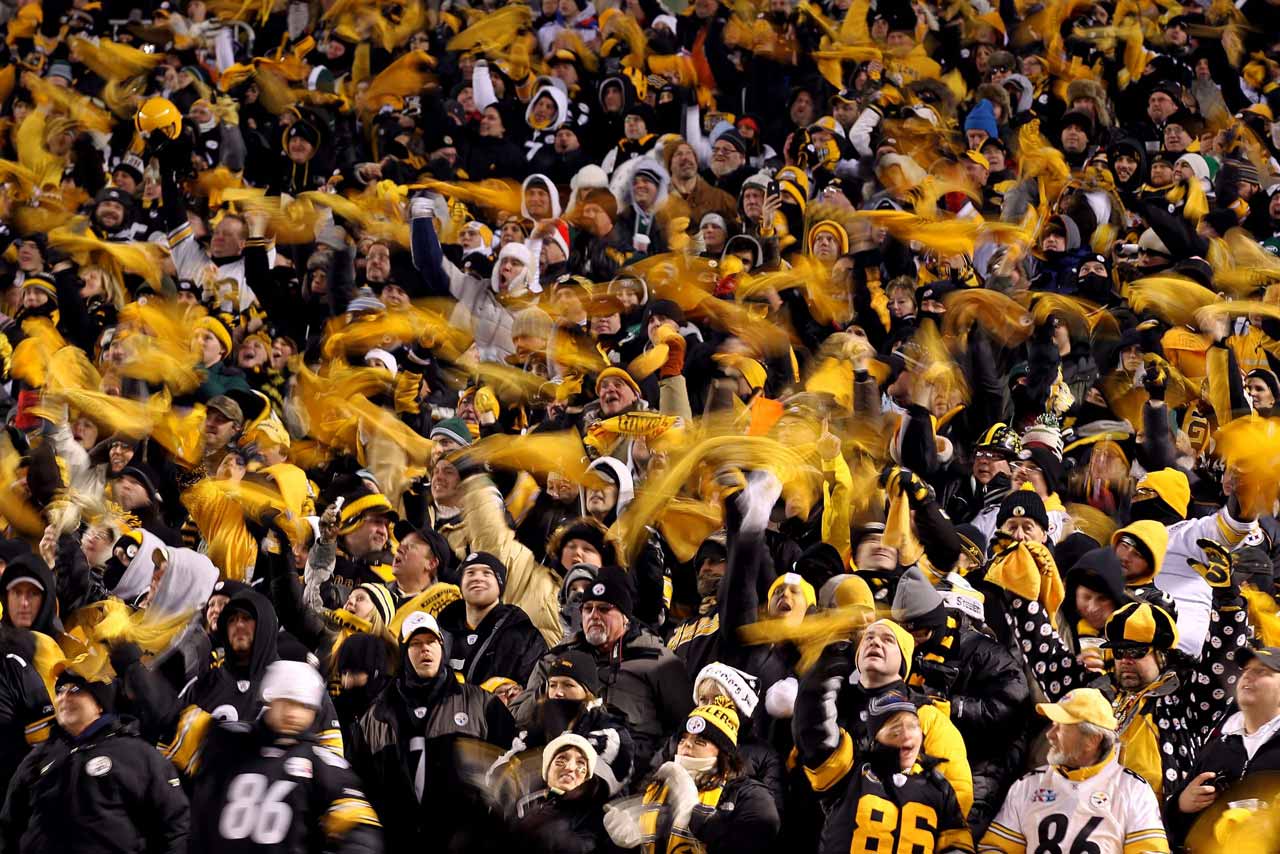For generations, the Pittsburgh Steelers have built and cultivated a reputation based on a blue-collar, what-you-see-is-what-you-get premise. The club has seen a lot of evolutions to the sport of football since their inception in 1933. Included in that are a multitude of rule changes, league mergers, salary cap requirements, and venue enhancements. Amongst those evolutions, in the 90 years of the organization’s life, there has been the underlying notion of the only constant in football is change. As we are now well within the throws of the 2023 season, more league change proposals are back on NFL Commissioner Roger Goodell’s desk.
-544x306.jpg)
Keith Srakocic / ASSOCIATED PRESS
NFL Commissioner Roger Goodell (left) visits with the Steelers front office and Head Coach Mike Tomlin in 2010.
In the franchise's lifetime, the Steelers have called four different venues their home. Those include Forbes Field, Pitt Stadium, Three Rivers Stadium, and now Acrisure Stadium, which was formally referred to as Heinz Field. Each of those venues possessed different iconic features that have led to the current venue today. But one massive change the Steelers made from the change of Three Rivers Stadium to then-Heinz Field was one that wasn’t too popular outside of Pittsburgh. But now 22-years later, the rest of the league, including the NFL Players Association (NFLPA) is finally coming around to how the Steelers have been doing things.
First, let’s review some history. The invention of AstroTurf by Monsanto in 1965 changed the entire sports landscape in America. Instead of investing in sod that had to be grown, cultivated, tamed, treated, and replanted each season, teams were able to simply roll out a glorified carpet to mimic grass. Aside from the significant cost savings each year, teams also created a way to build large indoor stadiums, without the need to install expensive irrigation systems for the playing surface. But there was a major flaw in the design that has been swept under the rug for years.
In a report written by Allan Mazur and Jennifer Bretsch at the University of New Hampshire in 1999, they cited a study that was published by Monsanto in 1968 claiming AstroTurf was able to reduce injuries by 80 percent. That claim was seemingly baseless, as they were simply accounting for divots, scuffs, and small holes in grass that appear through games that, according to Monsanto, could cause injuries their product couldn’t.
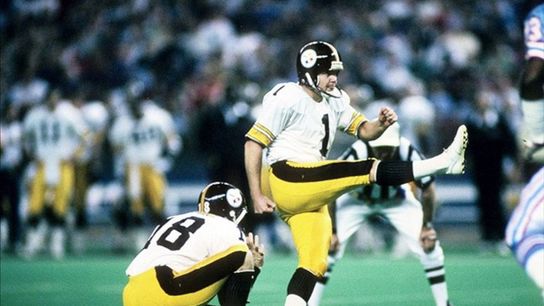
Richard Mackson / US PRESSWIRE
Steelers Gary Anderson (#1) kicks a field goal at the Astrodome in 1989.
However, Mazur and Bretsch would continue to reveal another study conducted by The New York Times in partnership with Dr. James Garrick of the University of Washington in 1971. In that study, Dr. Garrick presents Monsanto’s claims from 1968 were very much wrong, and that the product actually causes more injuries than grass does. For those keeping score, this debate occurred over 50 years ago.
When Three Rivers Stadium opened in 1970, the craze of artificial turf took over the design. On paper, it made sense. The Steelers would share the venue with the Pittsburgh Pirates, and with there being year-round traffic on the field, maintaining a grass field would be too much of a challenge. Hence, the developers installed 3M’s Tartan Turf, which was the first time a multi-purpose venue in America has done so. However, through the years of countless memories on the field, a combined six championships between the Pirates and Steelers, and 30 years of history embedded in Three Rivers Stadium, the late Dan Rooney and Art Rooney Jr. knew they needed to go back to their literal roots with their new stadium.
The NFLPA Finally Realizes Steelers Were Correct With Grass Fields
In the development of the new Pirates’ and Steelers’ venues of 1999 to 2001, the city of Pittsburgh put up $803 million to cover the different projects along Pittsburgh’s North Shore. Both of the new stadiums would go away from the artificial turf they’ve known for three decades prior and would replace it with their own unique grass sod. The Steelers’ head groundskeeper at the time, Tim Keene, worked closely with field construction experts at S.W. Franks to learn more about how to maintain an efficient grass field. During the construction of the field, Keene explained what the key was for him and his team in managing their first grass turf.
“We learned from the practice complex which rootzone mix and other components were correct for the Pittsburgh area and our athletes.”
When Heinz Field opened in 2001, it took some time for the players to get used to playing on grass. Not to mention, in Pittsburgh’s climate featuring a heavy dose of rain, snow, ice, and frigid cold, the conditions aren’t ideal for a manicured green field for each game played between October and January. Although there was careful consultation done leading up to the field’s unveiling, the grounds crew had to replace the sod several times in the early years of the stadium to keep up with the wear and tear.
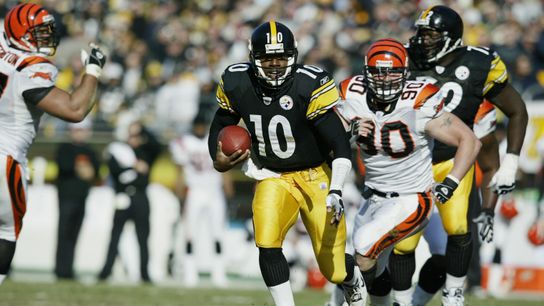
Tom Pidgeon / Getty Images
Kordell Stewart (#10) runs away from Cincinnati Bengals defenders in November, 2002.
Naturally, this led to criticism from players. In a 2002 game against the Cincinnati Bengals, the field conditions were historically bad for both teams. Further, some even said that the field was the worst they’ve played on in their respective careers and it impacted the outcome of the game, being a 29-21 Steelers’ victory.
“The field was tough. It was hard to move on,'' Hall of Fame running back Jerome Bettis said. "Fortunately for me, I'm bigger than a lot of guys and I kind of sunk down into it.''
After a few years of getting used to the grass, players and coaches began to favor the home field. In fact, they embraced it. When the time came to re-evaluate the playing surface in the 2008 offseason, Rooney Jr. took a poll around the organization, including every player, coach, and personnel member. In conclusion, Rooney Jr. decided to keep with the grass sod, seeing as that is how members of the organization felt.
"Our players and coaches, and the whole staff here, everybody had a chance to participate in the discussion and everyone was in favor of sticking with the grass," Rooney, Jr. said. "I think if you ask every player in the league the simple question, 'Would you rather play on grass or artificial?' It would be predominantly grass. The artificial I think is something they're willing to live with in most cases and they rate some surfaces better than others, but the majority of them definitely want to practice on grass and prefer playing the games on grass. It's been that way for a long time in my experience."
If we fast forward to today, the debate that began in 1971 is prevalent today more than ever. Football fans across the country tuned into the first 2023 edition of ESPN’s Monday Night Football to watch New York Jets quarterback Aaron Rodgers get carted off the field with a torn Achilles tendon. That injury ended the season for Rodgers and likely any playoff hopes for the Jets this season.
Seeing as though the injury occurred on the artificial turf of Metlife Stadium, Rodgers’ injury as spurred the playing surface debate once again. Rodgers’ former offensive tackle, David Bakhtiari, shared studies on X (formally Twitter) after the Rodgers injury. This continue to prove what Dr. Garrick claimed back in 1971.
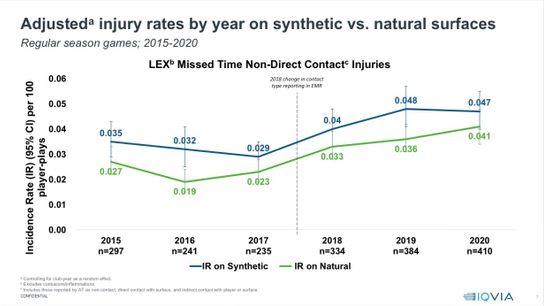
X / Twitter / @David Bakhiari
Graphic showing annual injury rates from 2015 to 2020 on artificial versus natural grass.
As a result of the common consensus across the players union, NFLPA executive director Lloyd Howell, released a statement to Goodell and the NFL pleading for grass field unanimously across NFL venues.
"Moving all stadium fields to high quality natural grass surfaces is the easiest decision the NFL can make," he proclaimed. "The players overwhelmingly prefer it and the data is clear that grass is simply safer than artificial turf. It is an issue that has been near the top of the players' list during my team visits and one I have raised with the NFL."
Ironically enough, that is exactly what Rooney Jr. discovered in 2008. Not to mention, thinking back to Dr. Garrick’s study in 1971 highlighting the increased risk of injury on artificial turf versus grass, the question of, "What’s taken so long" to the NFL owners looms large. Although the players will get dirtier, muddier, and sloppier compared to an artificial turf, they all agree the injury risk is much lower with grass.
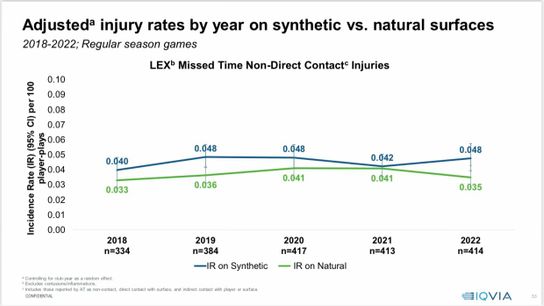
X / Twitter : @DavidBakhiari
Study showing injury rates from 2018-2022 comparing artificial versus natural grass.
This is something the Steelers knew when they constructed their current stadium, but was ridiculed for changing to a grass field. Since, we’ve even seen teams do the opposite by going from natural grass fields to artificial turf in the way of the Carolina Panthers, New England Patriots, and Tennessee Titans. But if history, statistics, and the threat of possible player hold-outs, the NFL could see another significant shift in player safety in the near future. As Steelers fans, it is good to see the rest of the league finally realizing how correct the organization has been for decades.
Do you like the Steelers grass field? What approach do you think the league should take? Let us know in the comments below!
#SteelerNation

-544x306.jpg)
